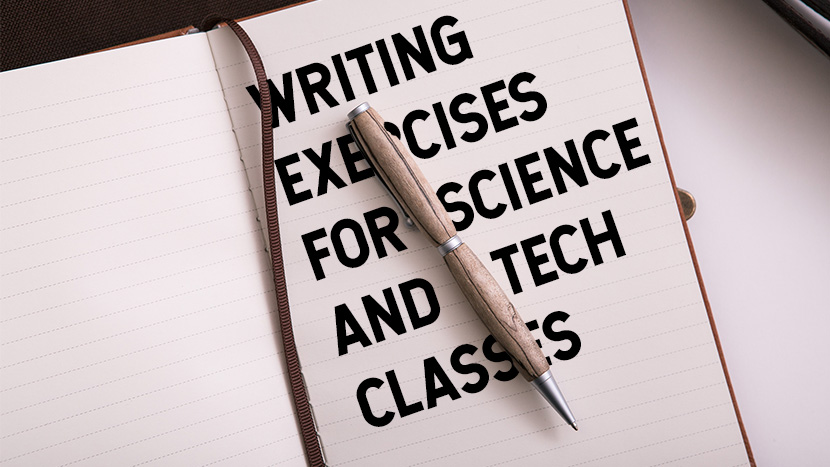Writing Exercises for Science and Technology Classrooms
Writing strategies in science and technology classes improve students’ ability to summarize information and make connections between new information and experiences.
When students write, they are active learners. The process itself has been shown to increase students’ understanding of concepts and provides an outlet through which to make connections.
Writing in science and technology classrooms shows students that these subjects are not as much about the memorization of facts as the discovery of something new and how to communicate what has been found. This can be done through a variety of summative and exploratory exercises, including the process of learning how to write compare and contrast essay. Through these writing exercises, students learn to identify similarities and differences, develop a clear thesis statement, and organize their thoughts effectively.
The Importance of Writing in Science and Technology
In science and technology classrooms, writing serves many purposes. It allows students to document their observations, experiment results, and research findings. This documentation forms a crucial part of the scientific process, helping students to reflect on their work and communicate their ideas effectively.
Moreover, writing helps students to synthesize information, organize their thoughts, and make connections between different concepts. For instance, when students write about a technology or scientific concept, they must first understand it thoroughly. They then need to break it down into its constituent parts, explain these in easy-to-understand language, and show how they connect. This process enhances their comprehension and retention of the material.
Summary Exercises
Writing assignments that summarize information take a variety of forms in science and technology classrooms. Lab reports are commonly utilized to not only collect student data and provide context for the scientific method but also provide a medium through which students analyze what they observe and provide concluding thoughts. Paragraphs or essays can be assigned to evaluate a scientific article. More advanced students could send a letter to the editor of a scientific or technical journal.
Other student-centered summative exercises include shorter writing pieces. Students can write a sentence or two to answer a question about a homework assignment. They can write an explanation to go with a graph, diagram, or model. True or false questions on an assessment can also become a writing practice when students are asked to provide a rewording of a false statement so that it becomes true.
Exploratory Exercises
Though not as precise as summative exercises, exploratory writing has an important place in science and technology classrooms. These exercises are less formal and encourage students to make connections between known concepts or explore new ideas by using what they already know.
One way to incorporate writing in this informal manner is to utilize brainstorming. Brainstorming allows students to think about what they already know and how it might be related to the problem or question posed. You could get students to brainstorm ideas and put it into an AI for essay writing then analyze what they think turned out well, and what they would do better if they had written it themselves.
Journal Assignments
Another informal writing exercise that can promote critical thinking and help develop new connections with new material is through the use of a journal. Journal assignments can take many forms, from requiring a specified number of entries, to having the student’s choose how often they write each week, or even providing specific questions or statements for students to contemplate through their writing.
Research Papers
Writing a research paper requires students to delve deep into a specific topic within science or technology. This process necessitates a comprehensive understanding of the subject. Students must read widely, analyze existing literature, and synthesize information from various sources. In doing so, they gain a more profound, layered understanding of the topic at hand.
Research papers promote independent learning. Rather than relying solely on classroom instruction, students must take the initiative to seek out information, understand complex concepts, and draw their own conclusions. This fosters a sense of responsibility for their learning and prepares them for future academic and professional pursuits where self-directed learning is key.
Reflection Essays
Reflection essays require students to think deeply about what they have learned, understand the concepts at a deeper level, and articulate their thoughts. By reflecting on a particular lesson, experiment, or project, students have the chance to consolidate their understanding, identify areas of confusion, and determine strategies to improve their learning.
Reflection essays can help bridge the gap between theory and practice. After experimenting, for instance, students can reflect on the results and how they relate to the theoretical concepts they’ve studied. This process helps them see the relevance of what they’re learning and apply theoretical knowledge to practical situations.
Technical Documentation
Writing technical documents requires students to have a comprehensive understanding of the subject. They need to break down complex ideas into simple, digestible pieces of information. This process reinforces their understanding and helps them view the topic from different perspectives.
Technical documentation also enhances students’ communication skills. It encourages them to write precisely and logically, making complex information understandable to non-experts. This skill is crucial in the science and technology fields, where professionals often need to communicate their work to diverse audiences.
Incorporating technical documentation in the classroom also prepares students for real-world scenarios. Whether they’re writing user manuals, product specifications, or technical reports, students get a taste of what’s expected in a professional setting. This experience can be invaluable when they step into the workforce.
Conclusion
When writing for science or technology classes, students should aim to be logical and objective. Unless the writing is exploratory, it should also be quantitative and verifiable. Students should be encouraged to avoid the first person, be organized, and provide data or references whenever appropriate. Writing is introduced in this context to develop critical thinking skills while increasing their understanding of the concepts.


































































































